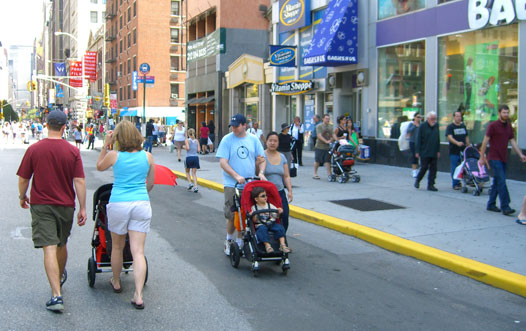What Does Summer Streets Mean for Business?

All this relaxed foot traffic surely brought a smile to the face of many a retailer and restaurateur
While press coverage of Summer Streets has been generally positive, tales of the miffed muffler shop owner and complaining cabinet maker are bound to continue, as reporters hunt for naysayers to "balance" out their stories. But what will be the economic reality of Summer Streets? Here, Streetsblog Publisher Mark Gorton gives his account of Saturday lunch with the family at an outdoor café on Park Avenue and 51st Street.
The host told us that he could seat us, but that they couldn’t put our order in for at least a half hour because the kitchen was so backed up. He said on a normal Saturday they would have had three or four tables occupied, but there were about 30 tables filled. He pointed and said, "Look, even the manager is taking tables." We were happy to wait, so we sat and ate. As I looked around the café, only a couple tables looked to be filled by bikers. My guess is that lots of people who would never have bothered to walk along Park Ave. on a Saturday suddenly found it an interesting place to be.
Most of the stories we’ve seen reflect Mark’s experience: In general, businesses which rely on foot traffic expected and/or received a boost from Summer Streets. Streetsblogger Larry Littlefield has suggested altering the route to exclude more car-dependent enterprises, like furniture stores.
What else could, or should, the city do — if anything — to take such businesses into account? And how did (or will) Summer Streets affect your spending habits?
Photo: Ben Fried





